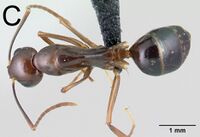Camponotus bozaka
| Camponotus bozaka | |
|---|---|

| |
| Scientific classification | |
| Kingdom: | Animalia |
| Phylum: | Arthropoda |
| Class: | Insecta |
| Order: | Hymenoptera |
| Family: | Formicidae |
| Subfamily: | Formicinae |
| Tribe: | Camponotini |
| Genus: | Camponotus |
| Subgenus: | Myrmosaga |
| Species: | C. bozaka |
| Binomial name | |
| Camponotus bozaka Rakotonirina & Fisher, 2022 | |
Known only from the south-central high plateau of Madagascar, C. bozaka occupies rubicole thicket, Uapaca woodland, savannah grassland, and shrubland habitats. Worker specimens have been found foraging through leaf litter and on low vegetation. The nest sites are in the ground or under stones.
Identification
Rakotonirina and Fisher (2022) - With head in full-face view, lateral margin of head anterior to eye level parallel, lacking erect hairs; clypeus with noticeable anterolateral corner; in profile, petiolar node anteroposteriorly compressed.
See also discussion under Camponotus asara.
Keys including this Species
Distribution
Distribution based on Regional Taxon Lists
Malagasy Region: Madagascar (type locality).
Distribution based on AntMaps
Distribution based on AntWeb specimens
Check data from AntWeb
Countries Occupied
| Number of countries occupied by this species based on AntWiki Regional Taxon Lists. In general, fewer countries occupied indicates a narrower range, while more countries indicates a more widespread species. |

|
Estimated Abundance
| Relative abundance based on number of AntMaps records per species (this species within the purple bar). Fewer records (to the left) indicates a less abundant/encountered species while more records (to the right) indicates more abundant/encountered species. |

|
Biology
Castes
Nomenclature
The following information is derived from Barry Bolton's Online Catalogue of the Ants of the World.
- bozaka. Camponotus bozaka Rakotonirina & Fisher, 2022: 63, figs. 26A, 28B, 48 (s.w.) MADAGASCAR.
- Type-material: holotype worker (caste not indicated), 1 paratype major worker.
- Type-locality: holotype Madagascar: Fianarantsoa, Parc Nat. d’Andringitra, Plateau d’Andohariana, 39.8 km. 204° Ambalavao, -22.18767, 46.90083, 2150 m., 16.iv.2006, BLF13773 (B.L. Fisher, et al.); paratype with same data.
- Type-depository: CASC.
- Distribution: Madagascar.
Unless otherwise noted the text for the remainder of this section is reported from the publication that includes the original description.
Description
Worker
Morphological measurements: see Appendix 1 and Ratios of morphometric data for majors and minors
Minor In full-face view, lateral cephalic margins anterior to level of eye approximately parallel, evenly rounding to posterior margin; eye protruding and large (EL/CS: 0.28±0.01; 0.26–0.30), breaking lateral cephalic margin, level of its posterior margin located at ca. posterior 1/4 of head (PoOc/CL: 0.25±0.01; 0.23–0.26); frontal carinae close to each other, their distance equal to or smaller than smallest distance of one to the eye (FR/CS: 0.28±0.01; 0.28–0.29); clypeus with anterolateral corners, its anteromedian margin broadly triangular or convex; mandible with two apical teeth normally spaced; antennal scape relatively short (SL/CS: 1.19±0.05; 1.08–1.25). Promesonotum weakly convex, mesopropodeum almost flat; mesonotum flat immediately anterior to metanotal groove; metanotal groove weakly visible; dorsal margin of propodeum straight and joining declivity at a noticeable angle, propodeal dorsum < 2 × as long as declivity. Petiolar node scalelike with sharp dorsal margin; femur of hind leg rounded axially and not twisted basally.
First and second gastral tergites without a pair of white spots; erect hairs on lateral margin of head not present; posterior margin of head with two erect hairs; with head in profile, four pairs of erect hairs arranged from level of anterior margin of eye to posterior cephalic margin; antennal scape covered only with appressed hairs; pronotum, mesonotum, and posterodorsal angle of propodeum with a pair of erect hairs.
Major Differing from minor worker in the following characters: enlarged head (CS: 2.07±0.18; 1.91–2.40; CWb/CL: 0.95±0.03; 0.90–0.98) with slightly concave to almost straight posterior margin; apical 1/3 of antennal scape extending beyond posterior cephalic margin; robust mesosoma with length of propodeal dorsum approximately the same as height of declivity.
Type Material
- Holotype worker. MADAGASCAR: Province Fianarantsoa: Parc National d’Andringitra, Plateau d’Andohariana, 39.8 km 204° Ambalavao, -22.18767, 46.90083, 2150 m, rubicole thicket at base of cliff, under stone, 16 Apr 2006 (B.L. Fisher et al.) collection code: BLF13773, specimen code: CASENT0217309 (CAS).
- Paratype. 1 major worker with same data as holotype but with specimen code CASENT0071370 (CAS).
Etymology
This new name bozaka is a singular non-Latin noun used in apposition and is derived from the Malagasy word for “dried grass” in reference to the abundant grassland where this species occurs.

